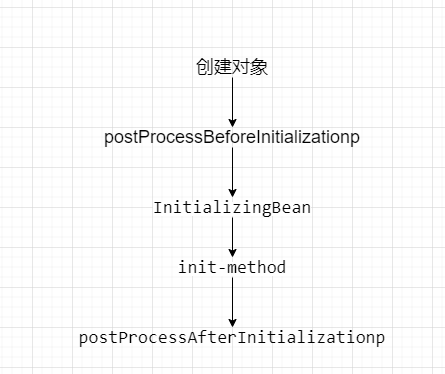Spring-IOC基本使用
通过上篇文章大概知道ioc、DI的概念了,下面我们详细介绍一下
一、Spring IOC创建对象
IOC通过上文的介绍作用是控制创建对象的解释权,我们把代码重新看一下
//User.java
public class User {
private String username;
private String password;
/**
* 省略有参无参构造器,getter/setter方法
*/
}
我们也不创建dao、service类了,直接就用这个User类来测试
配置文件:applicationContext.xml
<?xml version="1.0" encoding="UTF-8"?>
<beans xmlns="http://www.springframework.org/schema/beans"
xmlns:xsi="http://www.w3.org/2001/XMLSchema-instance"
xsi:schemaLocation="http://www.springframework.org/schema/beans http://www.springframework.org/schema/beans/spring-beans.xsd">
<!-- id:创建的bean的唯一标识,作用是区分其它的bean
class:创建的对象的全限定名(包名+类名) -->
<bean id="user" class="com.ty.bean.User"></bean>
</beans>
- bean的id获取IOC容器中的对象
//测试文件
public class MyTest {
ApplicationContext context=new ClassPathXmlApplicationContext("applicationContext.xml");
@Test
public void test1(){
User user = (User) context.getBean("user");
System.out.println(user);
}
}
这是IOC创建对象的第一种方式即通过bean的id获取IOC容器中的对象:context.bean("配置文件bean中的id")
还有另外两种方式 :
- 通过bean的类型获取对象:context.bean(注入对象的class类型)
@Test
public void test2(){
User user = context.getBean(User.class);
System.out.println(user);
}
这种注入方法有劣势,即:配置文件中有多个同类型的bean(即class重复)时,注入对象就会报错,例如:
<?xml version="1.0" encoding="UTF-8"?>
<beans xmlns="http://www.springframework.org/schema/beans"
xmlns:xsi="http://www.w3.org/2001/XMLSchema-instance"
xsi:schemaLocation="http://www.springframework.org/schema/beans http://www.springframework.org/schema/beans/spring-beans.xsd">
<!-- id:创建的bean的唯一标识,作用是区分其它的bean
class:创建的对象的全限定名(包名+类名) -->
<bean id="user" class="com.ty.bean.User"></bean>
<bean id="use2" class="com.ty.bean.User"></bean>
</beans>
再接着运行测试文件的时候就会报NoUniqueBeanDefinitionException异常

- 通过bean的id和类型获取对象:context.bean("配置文件bean中的id",注入对象的class类型)
@Test
public void test3(){
User user = context.getBean("user",User.class);
System.out.println(user);
}
二、SpringDI注入
光创建对象没用,最重要的还是为对象赋值,我们说过DI是IOC的实现,DI更能通过代码体现出来,接下开我们依次介绍几种赋值方式
1、属性注入(即setter注入)
1)简单类型(基本类型+String类型)
<bean id="user" class="com.ty.bean.User">
<!-- property:表示属性注入
name:属性的名字,其实是常规bean中set之后的名字(首字母小写)
value:属性值 -->
<property name="username" value="root"></property>
<property name="password" value="123456"></property>
</bean>
2)复杂类型(引用类型)
public class Address {
private String city;
/**
* 省略有参无参构造器,getter/setter方法
*/
}
public class User {
private String username;
private String password;
private String[] hobby;
private Address address;
private List list;
private Set set;
private Map map;
private Properties properties;
/**
* 省略有参无参构造器,getter/setter/toString方法
*/
}
<!-- private String[] hobby -->
<property name="hobby">
<array>
<value>吃饭</value>
<value>看电影</value>
<value>打游戏</value>
<!-- 表示赋空值,可以起占位作用-->
<null></null>
</array>
</property>
<!--private Address address- 可以有2种注入方式,一种方式在property标签嵌套一个bean-->
<!-- <property name="address">-->
<!-- <bean class="com.ty.bean.Address">-->
<!-- <property name="city" value="大连"></property>-->
<!-- </bean>-->
<!-- </property>-->
<!--ref:引用的bean的id-->
<property name="address" ref="address"></property>
<!-- private List list-->
<property name="list">
<list>
<value>a</value>
<value>b</value>
<value>c</value>
</list>
</property>
<!-- private Set set-->
<property name="set">
<set>
<value>redio</value>
<value>book</value>
<value>game</value>
</set>
</property>
<!-- private Map map-->
<property name="map">
<map>
<entry key="1" value="北京"></entry>
<entry key="2" value="上海"></entry>
<entry key="3" value-ref="address"></entry>
</map>
</property>
<!-- private Properties properties-->
<property name="properties">
<props>
<prop key="username">root</prop>
<prop key="password">root</prop>
</props>
</property>
</bean>
<bean id="address" class="com.ty.bean.Address">
<property name="city" value="大连"></property>
</bean>
List,Set,Map,Properties中还有一种注入方式,即util命名方式,主要的作用:方便别人引用
util命名空间方式
<!-- private List list-->
<property name="list" ref="mylist"></property>
<!-- private Set set-->
<property name="set" ref="myset"></property>
<!-- private Map map-->
<property name="map" ref="mymap"></property>
<!-- private Properties properties-->
<property name="properties" ref="myproperties"></property>
</bean>
<util:list id="mylist">
<list>
<value>a</value>
<value>b</value>
<value>c</value>
</list>
</util:list>
<util:set id="myset">
<set>
<value>redio</value>
<value>book</value>
<value>game</value>
</set>
</util:set>
<util:map id="mymap">
<entry key="1" value="北京"></entry>
<entry key="2" value="上海"></entry>
<entry key="3" value-ref="address"></entry>
</util:map>
<util:properties id="myproperties">
<prop key="username">root</prop>
<prop key="password">root</prop>
</util:properties>
3)P 命名空间方式
除了上方util命名空间方式之外搭配着还有一个P命名空间
<bean id="user2" class="com.ty.bean.User" p:username="root" p:password="123456" p:address-ref="address" p:list-ref="mylist"></bean>
4)自动注入
可以按照一定规则进行装配注入,不用具体指定为某个属性赋值,在工厂中查找一个bean,为属性注入属性值。
<bean id="address" class="com.ty.bean.Address">
<property name="city" value="上海"></property>
</bean>
<bean id="person" class="com.ty.bean.Person" autowire="byName"></bean>
byName:按照bean的id进行装配
byType:按照bean的类型来进行注入,但是如果有多个相同类型,就会报错,不知道选择哪一个具体的类型
2、构造器注入
public class User {
private String username;
private String password;
/**
* 省略有参无参构造器,getter/setter方法
*/
}
<bean id="user3" class="com.ty.bean.User">
<!--构造注入的constructor-arg标签里还有几个属性
name:形参列表的名称
value:实参的值
type:参数类型
index:参数索引,从0开始
-->
<constructor-arg name="username" value="root"></constructor-arg>
<constructor-arg name="password" value="123456"></constructor-arg>
</bean>
属性注入有P命名空间,构造器注入有C命名空间
1)C 命名空间
<bean id="user4" class="com.ty.bean.User" c:username="root" c:password="123456"></bean>
2)自动注入
<bean id="person" class="com.ty.bean.Person" autowire="constructor"></bean>
- constructor:使用构造器注入,形参列表必须要有对应 bean 对象
三、bean对象之间的关系
1、继承关系
<bean id="parent" class="com.ty.bean.User">
<property name="username" value="root"></property>
</bean>
<!--parent:指定继承的bean信息-->
<bean id="son" class="com.ty.bean.User" parent="parent"></bean>
2、抽象关系
这个是在继承关系的父bean里添加abstract属性,这个作用就是该bean是否能实例化
<bean id="parent" class="com.ty.bean.User" abstract="true">
<property name="username" value="root"></property>
</bean>
3、依赖关系
这个就是bean的先后创建顺序,depends-on依赖哪个bean就谁先创建谁,然后再创建本对象
<bean id="user5" class="com.ty.bean.User" depends-on="address"></bean>
<bean id="address" class="com.ty.bean.Address">
<property name="city" value="大连"></property>
</bean>
四、bean对象的作用域
通过scope属性指定当前bean的作用域,有四个值
singleton:单例模式,从IOC容器中获取的都是同一个对象,默认的作用域
prototype:多例模式,从IOC容器中获取的对象每次都是新创建
request:每次发送请求都会有一个新的对象
session:每一次会话都会有一个新的对象
<bean id="user5" class="com.ty.bean.User" scope="singleton"></bean>
ps:singleton作用域:每次在创建IOC容器完成之前此对象已经创建完成,即:
ApplicationContext context=new ClassPathXmlApplicationContext("applicationContext.xml");
prototype作用域:每次是在需要用到此对象的时候才会创建,即
User user = (User) context.getBean("user");
五、工厂对象
静态工厂
工厂本身不需要创建对象,但是可以通过静态方法调用,对象=工厂类.静态工厂方法名();
public class PersonStaticFactory {
public static Person getInstance(String name){
Person person=new Person();
person.setId(1001);
person.setAge(18);
person.setName(name);
return person;
}
}
<!--静态工厂:类名.静态方法()-->
<bean id="person" class="com.ty.factory.PersonStaticFactory" factory-method="getInstance">
<constructor-arg value="jack"></constructor-arg>
</bean>
实例工厂
工厂本身需要创建对象,工厂类 工厂对象=new 工厂类;工厂对象.get对象名();
public class PersonInstanceFactory {
public Person getInstance(String name){
Person person=new Person();
person.setId(1001);
person.setAge(18);
person.setName(name);
return person;
}
}
<!--实例工厂:先创建工厂实例,然后调用工厂实例的方法
factory-bean:表示具体工厂类的实例
factory-method:表示具体工厂实例的方法
-->
<bean id="factory" class="com.ty.factory.PersonInstanceFactory"></bean>
<bean id="person" class="com.ty.bean.Person" factory-bean="factory" factory-method="getInstance">
<constructor-arg value="jack"></constructor-arg>
</bean>
继承FactoryBean
FactoryBean是Spring规定的一个接口,当前接口的实现类,Spring都会将其作为一个工厂,但是在ioc容器启动的时候不会创建实例,只有在使用的时候才会创建对象
public class MyFactoryBean implements FactoryBean {
/**
* 此方式是spring创建bean方式的一种补充,用户可以按照需求创建对象, 创建的对象交由spring IOC容器来进行管理,无论是否是单例,都是在用到的时候才会创建该对象,不用该对象不会创建
*/
@Override
public Person getObject() throws Exception { //创建的对象
Person person=new Person();
person.setId(1001);
person.setName("jack");
person.setAge(20);
return person;
}
@Override
public Class<?> getObjectType() { //返回对象的类型
return Person.class;
}
@Override
public boolean isSingleton() { //是否单例
return true;
}
}
<bean id="factoryBean" class="com.ty.factory.MyFactoryBean"></bean>
六、bean对象的对象的生命周期
创建
- scope="singleton"(不配置lazy-init="true"属性),每次在创建IOC容器完成之前此对象已经创建完成
- scope="prototype",每次是在需要用到此对象的时候创建(scope="singleton"配置lazy-init="true"属性也是这样)
初始化
在对象创建完成之后会调用初始化方法
实现InitializingBean接口
//实现这个方法,完成初始化操作
@Override
public void afterPropertiesSet() throws Exception {
System.out.println("afterPropertiesSet");
}
对象中提供一个普通的方法同时配置Spring配置文件:
public void init(){
System.out.println("init");
}
<bean id="p" class="com.ty.bean.Person" init-method="init"></bean>
顺序:对象的注入-》InitializingBean-》普通init-method
销毁
- 实现DisposableBean接口
@Override
public void destroy() throws Exception {
System.out.println("destory");
}
- 定义一个普通的销毁方法同时配置Spring配置文件
public void mydestory(){
System.out.println("mydestory");
}
<bean id="p" class="com.ty.bean.Person" scope="prototype" init-method="init" destroy-method="mydestory">
<property name="id" value="1001"></property>
</bean>
销毁方法只会在scope="singleton"时才会调用,而且需要对象关闭,例如:context.close()
七、配置bean对象初始化方法的前后处理方法
spring中包含一个BeanPostProcessor的接口,可以在bean的初始化方法的前后调用该方法,如果配置了初始化方法的前置和后置处理器,无论是否包含初始化方法,都会进行调用
public class MyBeanPostProcessor implements BeanPostProcessor {
//对象初始化之前执行
@Override
public Object postProcessBeforeInitialization(Object bean, String beanName) throws BeansException {
System.out.println("postProcessBeforeInitialization"+beanName);
return bean;
}
//对象初始化对象之后运行
@Override
public Object postProcessAfterInitialization(Object bean, String beanName) throws BeansException {
System.out.println("postProcessAfterInitialization"+beanName);
return bean;
}
}
<bean class="com.ty.bean.MyBeanPostProcessor"></bean>
<bean id="p" class="com.ty.bean.Person" scope="prototype" init-method="init" destroy-method="mydestory">
<property name="id" value="1001"></property>
</bean>

八、配置文件参数化
就是把Spring配置文件中需要经常修改的字符串信息,转移到一个更小的配置文件中,方便后期的维护
例如:数据库连接
<context:property-placeholder location="classpath:db.properties"></context:property-placeholder>
<bean id="dataSource" class="com.alibaba.druid.pool.DruidDataSource">
<property name="username" value="${jdbc.username}"></property>
<property name="password" value="${jdbc.password}"></property>
<property name="url" value="${jdbc.url}"></property>
<property name="driverClassName" value="${jdbc.driverClassName}"></property>
</bean>
jdbc.username=root
jdbc.password=root
jdbc.driverClassName=com.mysql.jdbc.Driver
jdbc.url=jdbc:mysql://localhost:3306/demo
//测试
@Test
public void test11() throws SQLException {
ApplicationContext context=new ClassPathXmlApplicationContext("applicationContext.xml");
DruidDataSource dataSource = context.getBean("dataSource", DruidDataSource.class);
System.out.println(dataSource);
System.out.println(dataSource.getConnection());
}
Spring-IOC基本使用的更多相关文章
- 【初探Spring】------Spring IOC(三):初始化过程---Resource定位
我们知道Spring的IoC起到了一个容器的作用,其中装得都是各种各样的Bean.同时在我们刚刚开始学习Spring的时候都是通过xml文件来定义Bean,Spring会某种方式加载这些xml文件,然 ...
- 【初探Spring】------Spring IOC(一)
IOC:Inversion of Control(控制反转).IOC它所体现的并不是一种技术,而是一种思想,一种将设计好的对象交给容器来管理的思想.IOC的核心思想就体现在控制.反转这两个词上面,要理 ...
- spring ioc
spring ioc是spring的核心之一,也是spring体系的基础,那么spring ioc所依赖的底层技术是什么的?反射,以前我们开发程序的时候对象之间的相互调用需要用new来实现,现在所有的 ...
- Spring IoC源码解析——Bean的创建和初始化
Spring介绍 Spring(http://spring.io/)是一个轻量级的Java 开发框架,同时也是轻量级的IoC和AOP的容器框架,主要是针对JavaBean的生命周期进行管理的轻量级容器 ...
- spring笔记6 spring IOC的中级知识
1,spring ioc的整体流程,xml配置 spring ioc初始化的流程结合上图 步骤编号 完成的工作 1 spring容器读取配置文件,解析称注册表 2 根据注册表,找到相应的bean实现类 ...
- 谈谈对Spring IOC的理解(转)
学习过Spring框架的人一定都会听过Spring的IoC(控制反转) .DI(依赖注入)这两个概念,对于初学Spring的人来说,总觉得IoC .DI这两个概念是模糊不清的,是很难理解的,今天和大家 ...
- 自己动手编写spring IOC源码
前言:对于spring IOC概念不是很了解的朋友可以阅读我上一篇博客--轻松理解spring IOC(这两篇博客也是由于我的个人原因导致现在才发布,惭愧啊).通过这篇博客的理解之后,相信大家会对sp ...
- spring ioc 源码解析
什么是ioc? 通俗的解释是:(spring)框架中,完成对象的创建和注入的容器. springIOC体系结构: spring IOC的创建是典型的工厂模式,这一系列的bean工厂如上所示. 其核心是 ...
- Spring:源码解读Spring IOC原理
Spring IOC设计原理解析:本文乃学习整理参考而来 一. 什么是Ioc/DI? 二. Spring IOC体系结构 (1) BeanFactory (2) BeanDefinition 三. I ...
- 谈谈对Spring IOC的理解
学习过Spring框架的人一定都会听过Spring的IoC(控制反转) .DI(依赖注入)这两个概念,对于初学Spring的人来说,总觉得IoC .DI这两个概念是模糊不清的,是很难理解的,今天和大家 ...
随机推荐
- InnoDB 中的缓冲池(Buffer Pool)
本文主要说明 InnoDB Buffer Pool 的内部执行原理,其生效的前提是使用到了索引,如果没有用到索引会进行全表扫描. 结构 在 InnoDB 存储引擎层维护着一个缓冲池,通过其可以避免对磁 ...
- oracle sql%notfound
SQL%NOTFOUND 是一个布尔值.与最近的sql语句(update,insert,delete,select)发生交互,当最近的一条sql语句没有涉及任何行的时候,则返回true.否则返回fal ...
- 深度优先遍历&广度优先遍历
二叉树的前序遍历,中序遍历,后序遍历 树的遍历: 先根遍历--访问根结点,按照从左至右顺序先根遍历根结点的每一颗子树. 后根遍历--按照从左至右顺序后根遍历根结点的每一颗子树,访问根结点. 先根:AB ...
- 20200523_mysql中文乱码
查看字符集: 方法一:show variables like '%character%'; 方法二:show variables like 'collation%';设置字符集: /*建立连接使用的编 ...
- moviepy音视频剪辑:headblur的参数r_blur卷积核以及fx、fy、r_zone的功能作用及用途
☞ ░ 前往老猿Python博文目录 ░ 在moviepy1.03版本中,headblur的调用语法为:headblurbak(clip,fx,fy,r_zone,r_blur=None) 其中参数f ...
- WindowsServer系统设置U盘引导及安装
准备一台服务器,我的服务器上图. 1.开机启动,按DEL进入BIOS.我的显示如下图,按F7进入. 2.找到设置启动项的地方 3.修改U盘启动项 4.保存退出. 5.重启服务器正常的话应该能够从U盘引 ...
- linux服务器性能分析只需1分钟
背景: 现在的互联网公司,大多数时候应用服务都是部署在linux服务器上,那么当你的服务运行过程中出现了一些响应慢,资源瓶颈等疑似性能问题时,给你60秒,如何快速完成初步检测? 肯定有人会说用工具,公 ...
- 5+App 相关记录
一.页面跳转到app 1.应用的manifest.json文件,plus --> distribute --> google 节点下,增加属性 schemes 2.打包后,在手机里安装. ...
- OpenResty&Canal
OpenResty&Canal OpenResty 提供缓存功能 封装了Nginx,并且提供了Lua扩展,大大提升了Nginx的并发处理能力10k~1000k Nginx限流 1.控制速率 2 ...
- uni-app中组件的使用
组件基本知识点: uniapp中:每个页面可以理解为一个单页面组件,这些单页面组件注册在pages.json里,在组件关系中可以看作父组件. 自定义可复用的组件,其结构与单页面组件类似,通常在需要的页 ...
